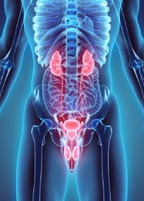Comparative effectiveness of surgical techniques and devices for the treatment of benign prostatic hyperplasia – German Summary of the EUnetHTA OCTA27 Assessment

Project leaders: Judit Erdös
Project team: Judit Erdös
& EUnetHTA partners (RER, VASPVT, SNHTA, Azienda Zero)
Duration: May 2020 – January 2021
Language: English with German summary
Publication: DSD No. 129: https://eprints.aihta.at/1328/
Background: Benign prostatic hyperplasia (BPH) is the most commonly diagnosed urological disorder in male patients. In the age group of 50-60-year-old, every second man is affected. BPH is a benign enlargement of the prostate. In a large proportion of BPH patients, prostate enlargement leads to the narrowing of the urethra (obstruction) and thus to moderate to severe symptoms of the lower urinary tract (LUTS) [1].
Prostate enlargement itself is not an indication for medical treatment. No intervention is therefore recommended for irritation symptoms (frequent urge to urinate / difficulty urinating) that are not accompanied by obstruction. Typically, about 80% of patients who have irritable symptoms are examined for obstruction; around 20% of these are candidates for surgery [2]. For men with clinically significant LUTS attributable to BPH and for whom medical treatment does not provide sufficient relief or who find the side effects of medical treatment to be disruptive, surgical treatment is an option. There are numerous surgical procedures, but transurethral resection of the prostate (TURP) is considered the standard method for the treatment of BPH [1].
Possible surgical interventions (and included in this review) are classified into:
1. Resection: open surgery, transurethral resection (TURP)
2. Incision: transurethral incision of the prostate (TUIP)
3. Ablation / Vaporization: Water vapor ablation (WAVE), laser ablation (photoselective vaporization of the prostate / PVP), electrovaporization (transurethral electrovaporization / TUEVP, bipolar TUEVP)
4. Enucleation: with laser (holmium laser / HoLEP, thulium laser / TULEP) or without laser (transurethral enucleation with bipolar energy / TUEB)
5. Urethral Lift (PUL)
6. Prostate Artery Embolization (PAE)
Project objective and research questions: The aim of this report is to evaluate the clinical benefit of minimally invasive surgical procedures in different subgroups depending on the size of the prostate. The following research questions will be answered:
Q1. What is the benefit of TUIP compared to TURP in men with a prostate size <35g and LUTS due to BPH?
Q2. What is the benefit of vaporization, urethral lift or prostate artery embolization compared to TURP in men with prostate size between 35g and 80g and LUTS due to BPH?
Q3. What is the benefit of enucleation compared to TURP in men with prostate size between 80g and 150g and LUTS due to BPH?
Q4. What is the benefit of enucleation compared to open prostatectomy in men with a prostate size> 150g and LUTS due to BPH?
Inclusion criteria (PICO)
Q1:
|
Population |
Adult men (>18 of age) with prostate size of <35g and LUTS due to BPH of non-neurological cause (defined by post-urination residue >100 ml and peak urinary flow <10) |
|
Intervention |
TUIP |
|
Comparator |
TURP |
|
Outcomes |
|
Q2:
|
Population |
Adult men (>18 of age) with prostate size of >35 - <80 g and LUTS due to BPH (defined by post-urination residue >100 ml and peak urinary flow <10) |
|
Interventions |
|
|
Comparator |
TURP |
|
Outcomes |
|
Q3:
|
Population |
Adult men (>18 of age) with prostate size of >80 to <150 g and LUTS due to BPH (defined by post-urination residue >100 ml and peak urinary flow <10) |
|
Intervention |
Enucleation (HoLEP, TULEP, TUEB) |
|
Comparator |
TURP |
|
Outcomes |
|
Q4:
|
Population |
Adult men (>18 of age) with prostate size of >150 g and LUTS due to BPH (defined by post-urination residue >100 ml and peak urinary flow <10) |
|
Intervention |
Enucleation (HoLEP, TULEP, TUEB) |
|
Comparator |
Open prostatectomy |
|
Outcomes |
|
Methods:
• Systematic literature search will be conducted in the following databases (MEDLINE via Ovid, Embase, Center for Research and Dissemination (CRD), Cochrane (CENTRAL).
• A handsearch in the reference lists of recent articles and on relevant websites (e.g. UpToDate) will complete the systematic literature search.
The PRISMA statement and the EUnetHTA Core Model ® will be used as reporting standards. All steps are carried out independently by two researchers: study selection, quality assessment of the included studies with appropriate tools, data extraction, and qualitative synthesis of the evidence using GRADE (Assessing the strength of evidence using the Grading of Recommendations, Assessment, Development and Evaluation). All discrepancies will be resolved by consensus or by involving a third researcher in case it cannot be resolved.
Milestones:
|
Period |
Activity |
|
May 2020 |
Scoping, preparation of the EUnetHTA project protocol |
|
June 2020 |
Literature search, selection of literature |
|
July-August 2020 |
Data extraction, synthesis and assessing the quality of the evidence |
|
September 2020 |
Writing/drafting the report |
|
October 2020 |
Internal review |
|
November-January 2021 |
External review, publication |
References:
[1] Vreugdenburg TD and Wild C, Prostate artery embolisation for benign prostatic hyperplasia. 2017, DSD 105, Ludwig Boltzmann Institute for Health Technology Assessment: Vienna. http://eprints.aihta.at/1118/1/DSD_105.pdf
[2] J. Curtis Nickel, M., FRCSC, Carlos E. Méndez-Probst, MDH, Thomas F. Whelan, MD, FRCSC, Ryan F. Paterson, MD, FRCSC, and Hassan Razvi, MD, FRCSCH, the Canadian Prostate Health Council and the CUA Guidelines Committee, 2010 Update: Guidelines for the management of benign prostatic hyperplasia. Can Urol Assoc J., 2010. 4(5): p. 310-316.















